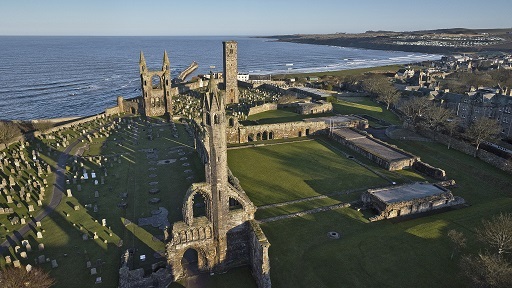St Andrews Cathedral
St Andrews Cathedral
St Andrews Cathedral was once the most important church in Scotland. It was the base for the country's senior bishopric and housed the relics of St Andrew (the nation's patron saint). For many centuries St Andrews Cathedral was the largest building in Scotland (it was only surpassed in the nineteenth century when Edinburgh's Waverley Station was built). During its long history the Cathedral suffered a number of disasters. In 1304 King Edward I of England stripped the lead from the roof to provide materials for his siege of Stirling Castle. Seventy years later, in 1378, a great fire damaged large portions of the Cathedral. Major restoration work was undertaken, and by the early fifteenth-century the church had been returned to its former glory. However, in 1559 the Scottish Reformation ended the Cathedral's religious function. The vast church rapidly became ruined and by 1690 it looked much as it does today.
Richard Fawcett on St Andrews Cathedral
Roger Mason on the significance of the St Andrews Cathedral and the reformation
Katie Stevenson on the gale force wind at the St Andrews Cathedral in 1410
Street View
Additional Information
Location: East of the junction between North Street and South Street. Date Built: Twelfth to fifteenth centuries.
People travelled from across Europe to visit the shrine of St Andrew. There are references to pilgrims from Scandinavia, Spain, Germany, France and England.
Pilgrims could buy badges showing St Andrew on his X-shaped cross. A number of these badges have survived. Some are on display in the St Andrews Museum.
The Cathedral was used for heresy trials. In 1528 Patrick Hamilton, Scotland's first Protestant martyr, was tried and condemned in St Andrews Cathedral.
Mary Queen of Scots' parents (James V and Mary of Guise) were married in St Andrews Cathedral in 1538.
Beggars used to wait by the Cathedral doors in hope of gifts from pious worshippers.
In June 1559 Protestants burnt statues and elaborate furnishings from the Cathedral in a great bonfire nearby. Other supposedly "idolatrous" works of art were dropped down the latrines.
